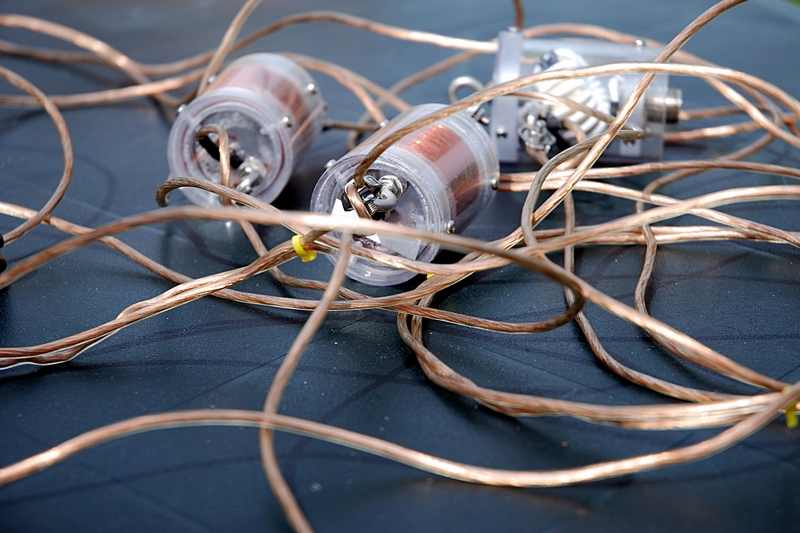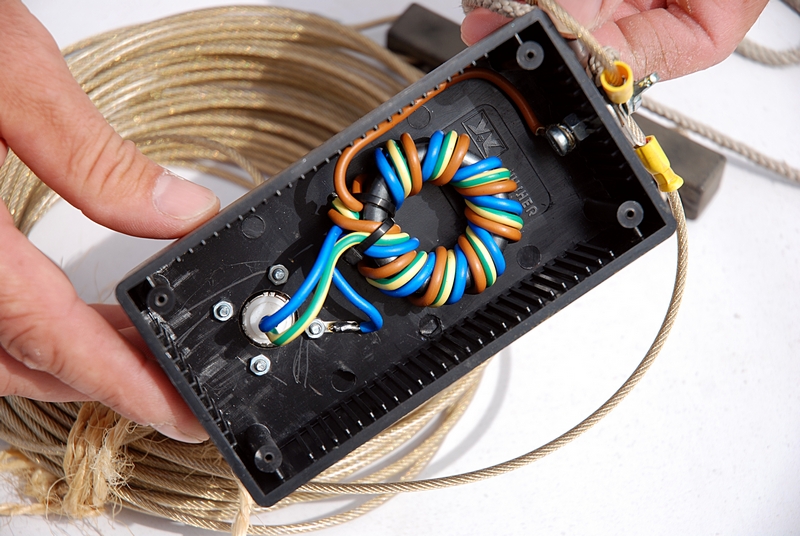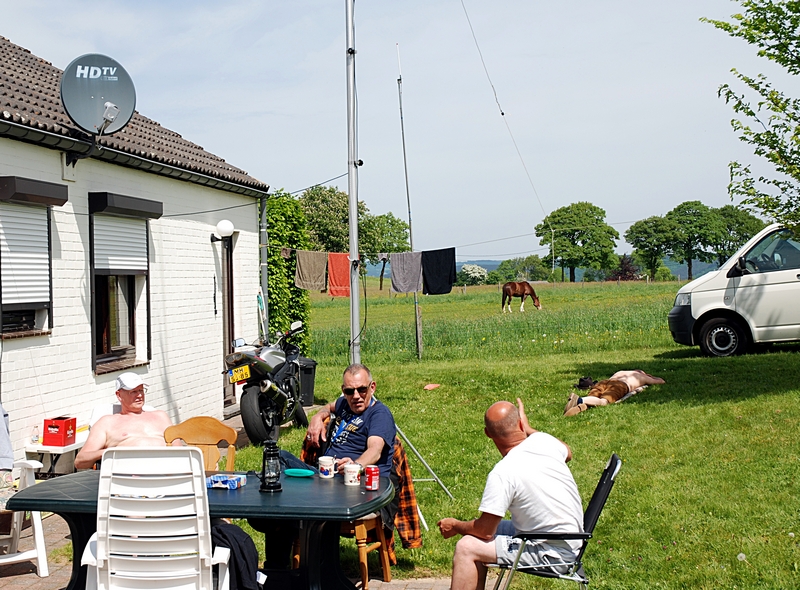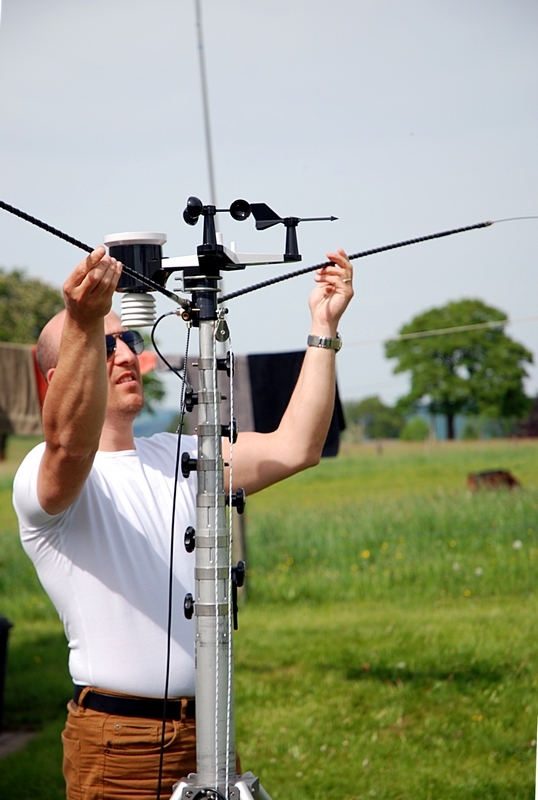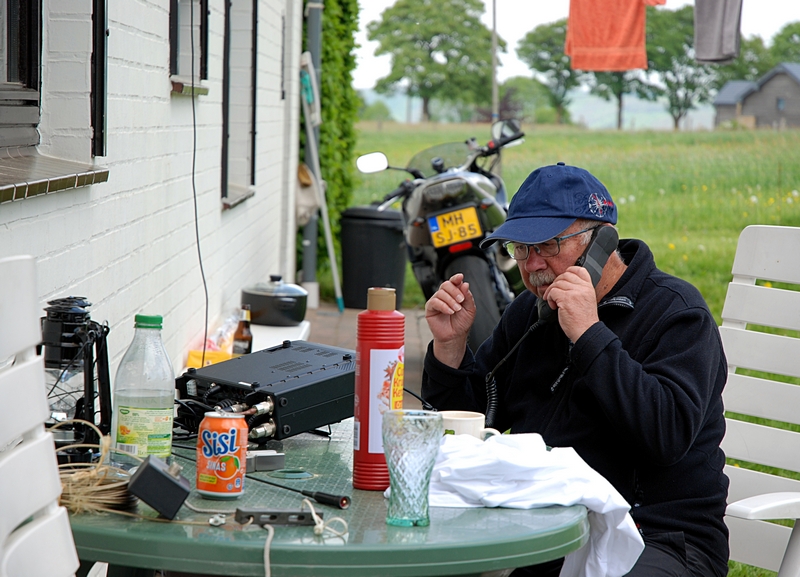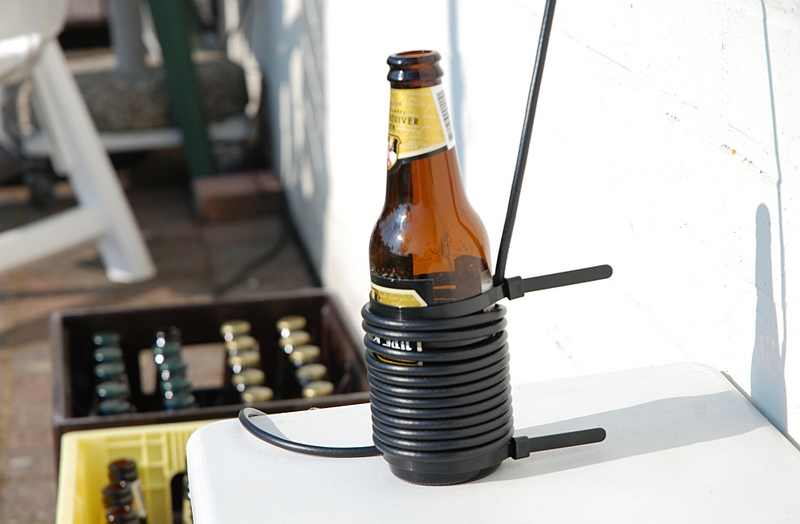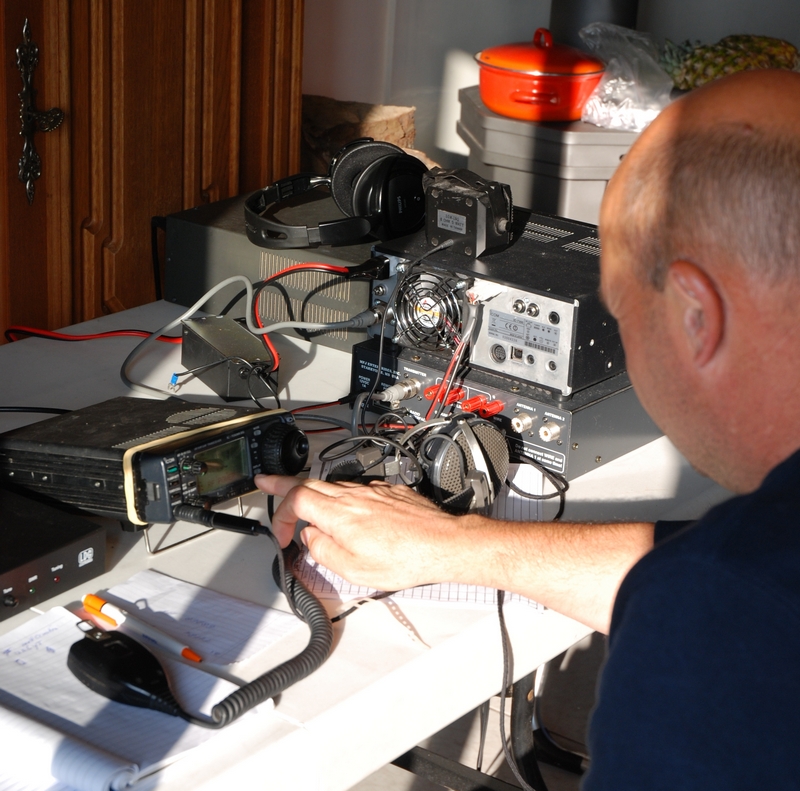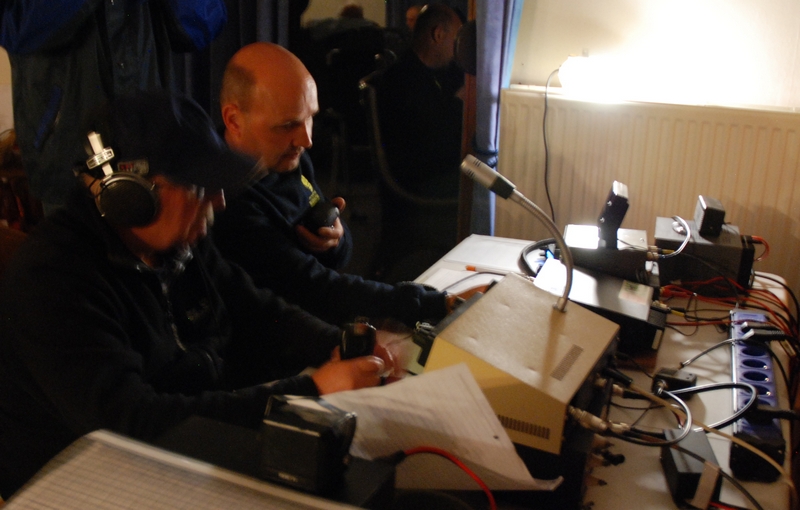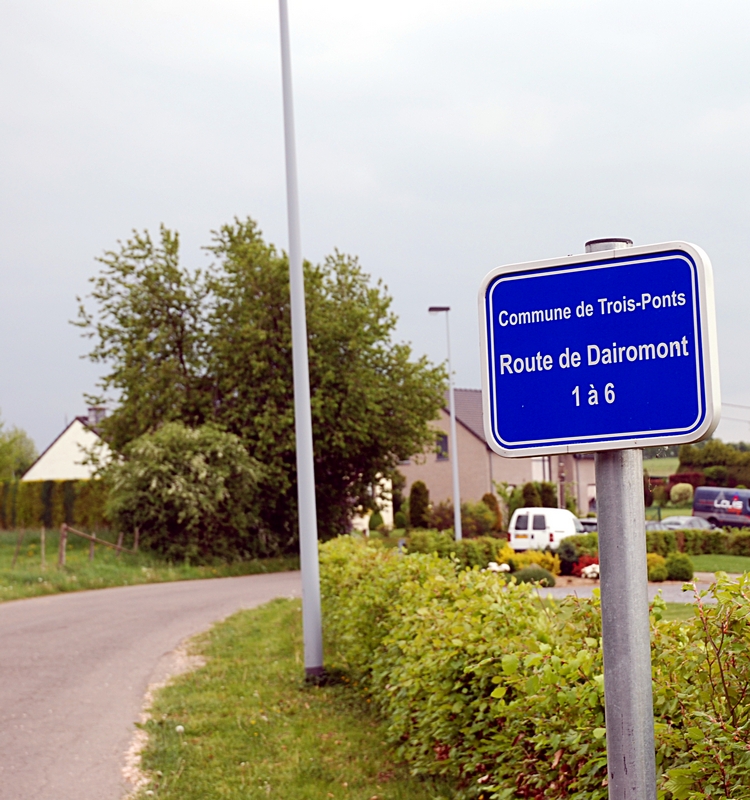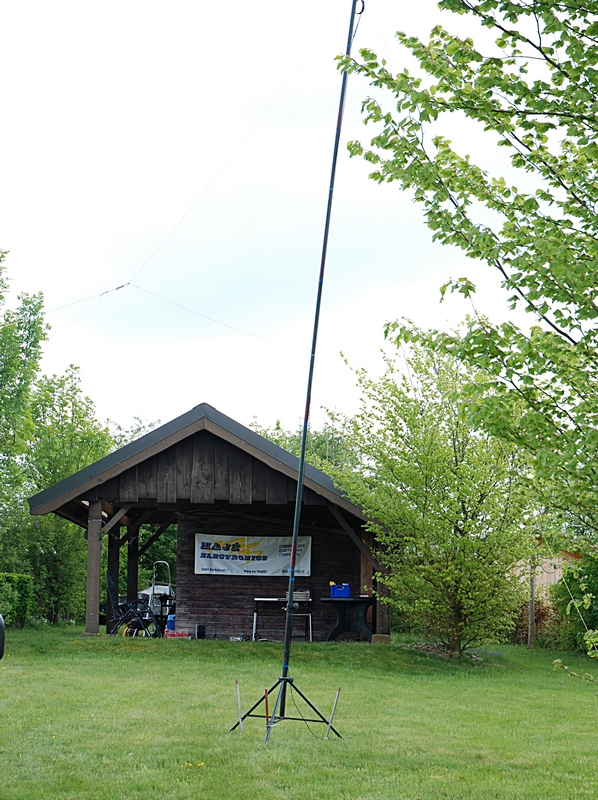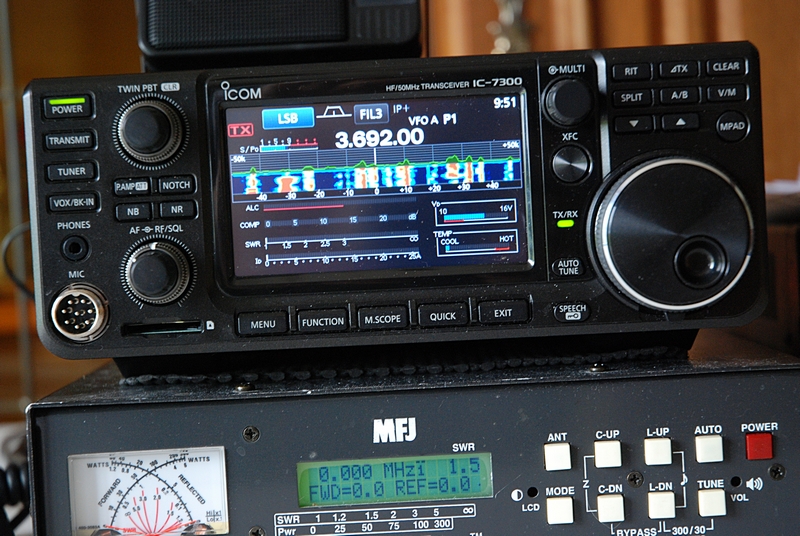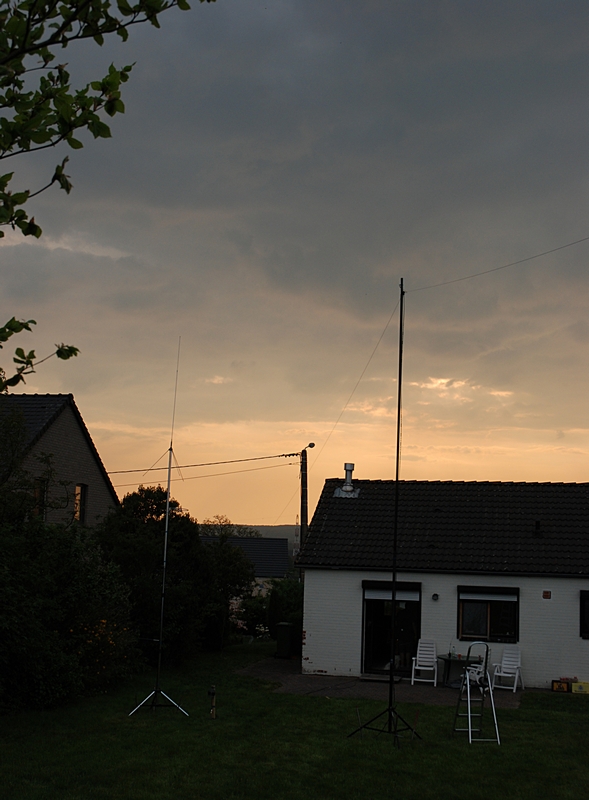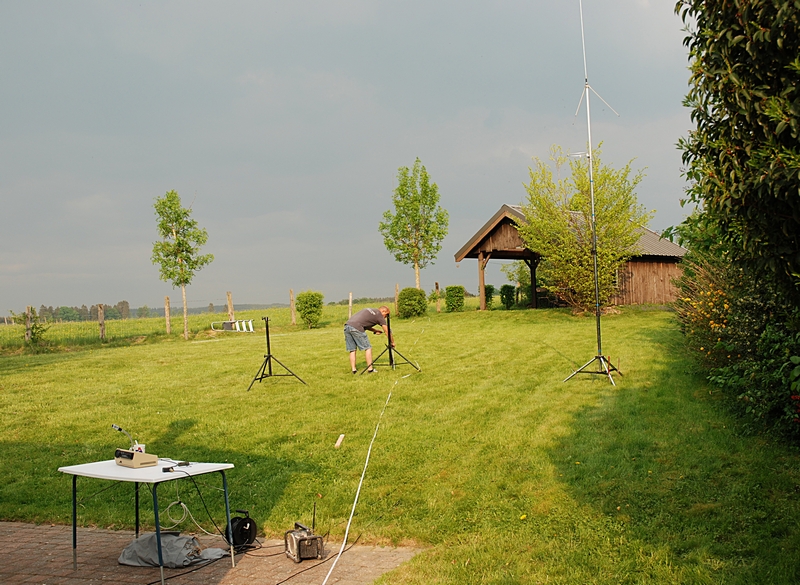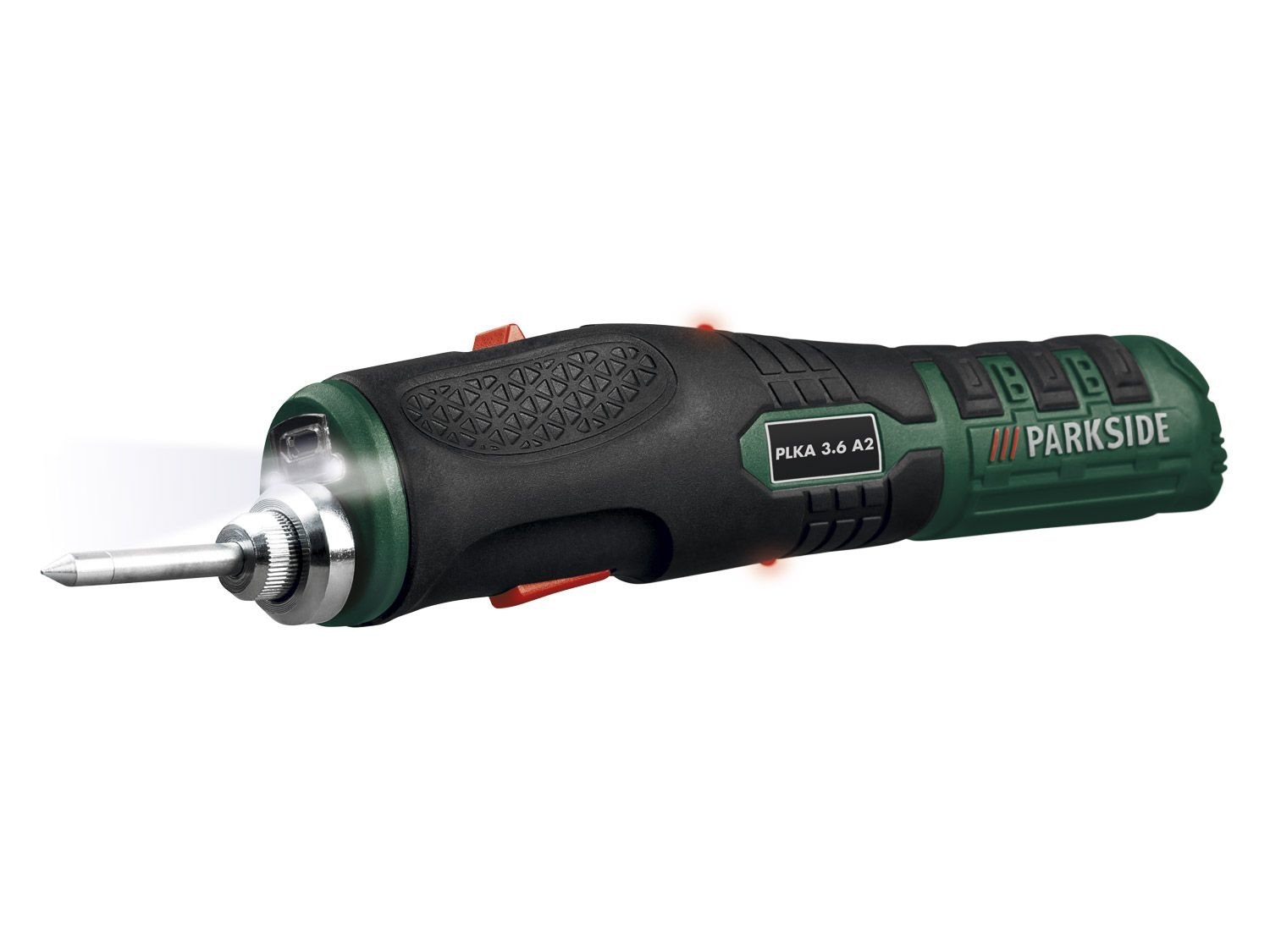Het was een mooie velddag met mooie foto’s:
Velddag 2018: Dairomont (nabij Malmédy)
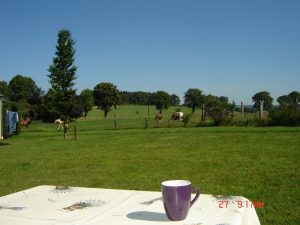 Na de succesvolle velddagen in Bellevaux is de VRZA Zuid-Limburg in 2018 verhuisd naar Dairomont, vlakbij Malmédy. Een uurtje rijden vanuit Maastricht ligt dit vakantiehuis bovenop een plateau met een prachtig uitzicht over de omgeving, zoals je op de foto kunt zien.
Na de succesvolle velddagen in Bellevaux is de VRZA Zuid-Limburg in 2018 verhuisd naar Dairomont, vlakbij Malmédy. Een uurtje rijden vanuit Maastricht ligt dit vakantiehuis bovenop een plateau met een prachtig uitzicht over de omgeving, zoals je op de foto kunt zien.
De velddag vindt plaats vanaf donderdag 10 mei (Hemelvaartsdag) tot en met zondag 13 mei. Tijdens deze dagen zullen 8 leden van de VRZA hun kamp opslaan en met diverse antennes en transceivers proberen zoveel mogelijk verbindingen te maken en experimenten te doen.
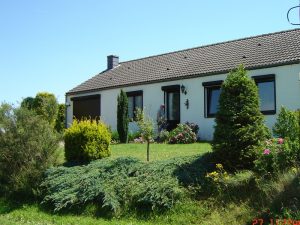 De velddag is natuurlijk ook te bezoeken. Hou er wel rekening mee dat er voor de maaltijden niet is gerekend op mee-eters dus zorg zelf voor eigen eten, indien nodig. Voor de consumpties wordt een bijdrage gevraagd. Wil je langs komen? Van harte welkom! Meld je even in via de repeater van Botrange: 439.0125 MHz (shift -7.6MHz, Tone – 131,8Hz), die staat continu aan tijdens de velddag.
De velddag is natuurlijk ook te bezoeken. Hou er wel rekening mee dat er voor de maaltijden niet is gerekend op mee-eters dus zorg zelf voor eigen eten, indien nodig. Voor de consumpties wordt een bijdrage gevraagd. Wil je langs komen? Van harte welkom! Meld je even in via de repeater van Botrange: 439.0125 MHz (shift -7.6MHz, Tone – 131,8Hz), die staat continu aan tijdens de velddag.
Parkeren in de buurt zal geen probleem zijn maar hou er rekening mee dat dit huisje in een gewoon dorp ligt dus hou rekening met omwonenden. De locatie is gewoon met de auto of motor te bereiken, je hoeft nu eens niet door het bos!
Weersverwachting
Het adres: Dairomont 27, 6698 Vielsalm, België:
Route
U volgt de A2 richting Maastricht – Luik
Net voor Luik neemt u de autosnelweg
Antwerpen – Luik – Aaken
(hier opletten, kort na elkaar juiste afslag kiezen! (Aaken-Vervier)
Na ± 10 km volgt u de autosnelweg richting Verviers – Spa – St. Vith.
Bij afslag Malmedy gaat u rechts richting Stavelot en daarna Trois-Ponts
(na 2 tunnels linksaf, daarna weg volgen)
In Trois-Ponts volgt u richting Hamoir – Huy.
(Neem bij voorkeur deze route. Uw navigatiesysteem geeft mogelijk
de kortste route (langs de kerk) aan! Deze is echter alleen toegestaan
voor lokaal verkeer en erg steil en smal!)
Even buiten de bebouwde kom van Trois-Ponts gaat u de eerste weg links
(bord richting Fosse sur Salm).
U volgt deze weg via Mont de Fosse en Bergeval en u nadert dan Mont Saint Jacques.
Bij het eerste huis links van de weg ± 50m voor de kerk gaat u bij de kruising (richting Vielsalm) linksaf.
Het eerstvolgende huis links van de weg is uw vakantiebestemming!
(Nabij het kerkje van Mont Saint Jacques, dus wat afwijkend van punt A op het kaartje hierboven op deze pagina!)
Tip: draadloze soldeerbout bij de Lidl
Temperature Sensor and Simple Oscillator Make a Value-Added HF Beacon
In the world of ham radio, beacon stations are transmitters that generally operate unattended from a known location, usually at limited power (QRP). Intended for use by other hams to determine propagation conditions, most beacons just transmit the operator’s call sign, sometimes at varying power levels. Any ham that can receive the signal will know there’s a propagation path between the beacon and the receiver, which helps in making contacts. The beacon that [Dave Richards (AA7EE)] built is not a ham beacon, at least not yet; operating at 13.56 MHz, it takes advantage of FCC Part 15 regulations regarding low-power transmissions rather than the Part 97 rules for amateur radio. The circuit is very simple — a one-transistor Colpitts oscillator with no power amplifier, and thus very limited range. But as an added twist, the oscillator is keyed by an ATtiny13 hooked to an LM335 temperature sensor, sending out the Celsius and Fahrenheit temperature in Morse every 30 seconds or so. The circuit is executed in Manhattan style, which looks great and leaves plenty of room for expansion. [Dave] mentions adding a power amp and a low-pass filter to get rid of harmonics and make it legal in the ham bands.
Beacons are just one of the ways for hams to get on the air without talking. Another fun way to analyze propagation is WSPR, which is little like an IoT beacon.
SDR IF Experiments
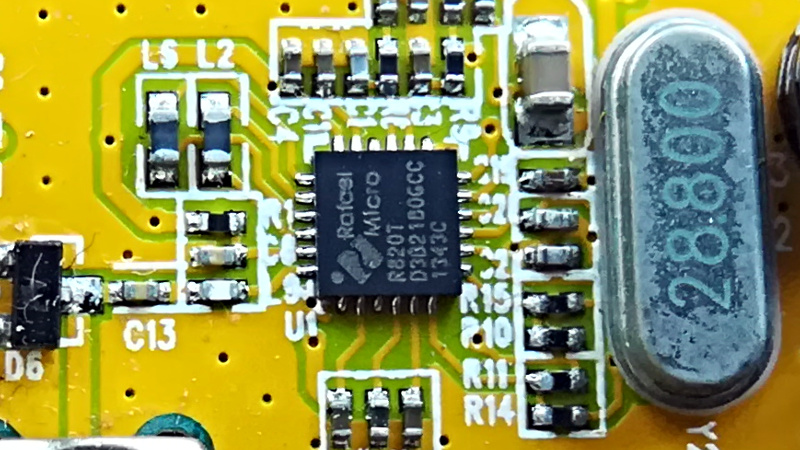 The R820T tuner IC is used in the popular Airspy software defined radio (SDR) as well as many of the inexpensive RTL SDR dongles. [TLeconte] did some experiments on intermediate frequency (IF) configuration of the chip, and you’ll find his results interesting.
The R820T tuner IC is used in the popular Airspy software defined radio (SDR) as well as many of the inexpensive RTL SDR dongles. [TLeconte] did some experiments on intermediate frequency (IF) configuration of the chip, and you’ll find his results interesting.Using 5 million samples per second and the device’s real mode, the tests look at a what comes out when the IC reads a noise source. There are two registers that set the IF parameters, but the tests show the effects these registers have in precise terms.
According to the post, there are three things you can set:
- Coarse IF filter bandwidth : narrow/mid/large
- Manual fine tuning IF filter bandwidth from 0 (large) to 15 (narrow)
- High pass filter frequency from 0 (high) to 15 (low)
Some of the settings don’t make sense — at least at the 5 MHz sample rate — because of aliasing. However, it is instructive to see what each setting does. [TLeconte] uses Octave to visualize the data.
If you want to know more about SDR in general, we have something to get you started. If you want to do your own testing, consider using GNU Radio.
An SSB Transceiver Using Only One Device? Surely not!
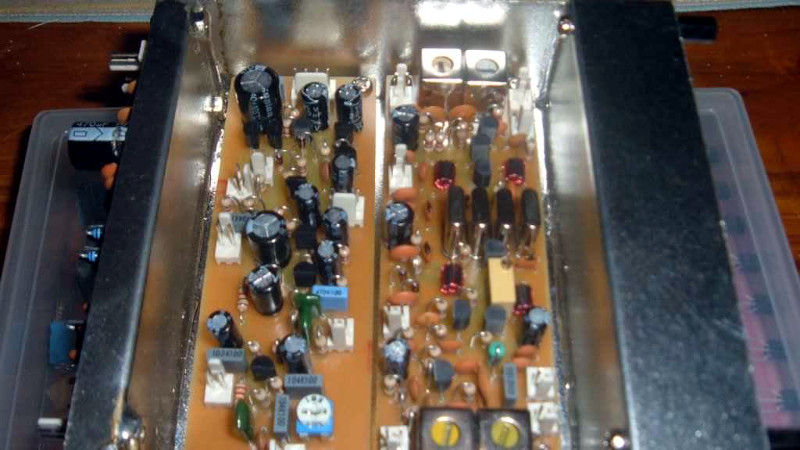
There are a multiplicity of transmission modes both new and old at the disposal of a radio amateur, but the leader of the pack is still single-sideband or SSB. An SSB transmitter emits the barest minimum of RF spectrum required to reconstitute an audio signal, only half of the mixer product between the audio and the RF carrier, and with the carrier removed. This makes SSB the most efficient of the analog voice modes, but at the expense of a complex piece of circuitry to generate it by analog means. Nevertheless, radio amateurs have produced some elegant designs for SSB transmitters, and this one for the 80m band from [VK3AJG] is a rather nice example even if it isn’t up-to-the-minute. What makes it rather special is that it relies on only one type of device, every one of its transistors is a BC547.
In design terms, it follows the lead set by other simple amateur transmitters, in that it has a 6 MHz crystal filter with a mixer at either end of it that switch roles on transmit or receive. It doesn’t use the bidirectional amplifiers popularised by VU2ESE’s Bitx design, instead, it selects transmit or receive using a set of diode switches. The power amplifier stretches the single-device ethos to the limit, by having multiple BC547s in parallel to deliver about half a watt.
While this transmitter specifies BC547s, it’s fair to say that many other devices could be substituted for this rather aged one. Radio amateurs have a tendency to stick with what they know and cling to obsolete devices, but within the appropriate specs a given bipolar transistor is very similar to any other bipolar transistor. Whatever device you use though, this design is simple enough that you don’t need to be a genius to build one.
Via [G4USP]. Thanks [2ftg] for the tip.
Review: LimeSDR Mini Software Defined Radio Transceiver

It’s fair to say that software-defined radio represents the most significant advance in affordable radio equipment that we have seen over the last decade or so. Moving signal processing from purpose-built analogue hardware into the realm of software has opened up so many exciting possibilities in terms of what can be done both with more traditional modes of radio communication and with newer ones made possible only by the new technology.
It’s also fair to say that radio enthusiasts seeking a high-performance SDR would also have to be prepared with a hefty bank balance, as some of the components required to deliver software defined radios have been rather expensive. Thus the budget end of the market has been the preserve of radios using the limited baseband bandwidth of an existing analogue interface such as a computer sound card, or of happy accidents in driver hacking such as the discovery that the cheap and now-ubiquitous RTL2832 chipset digital TV receivers could function as an SDR receiver. Transmitting has been, and still is, more expensive.
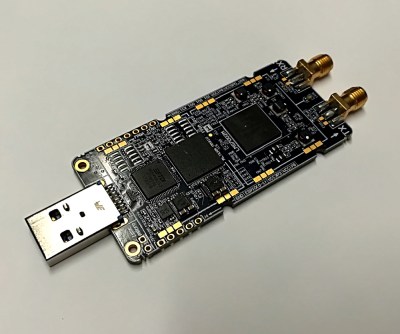
A new generation of budget SDRs, as typified by today’s subject the LimeSDR Mini, have brought down the price of transmitting. This is the latest addition to the LimeSDR range of products, an SDR transceiver and FPGA development board in a USB stick format that uses the same Lime Microsystems LMS7002M at its heart as the existing LimeSDR USB, but with a lower specification. Chief among the changes are that there is only one receive and one transmit channel to the USB’s two each, the bandwidth of 30.72 MHz is halved, and the lower-end frequency range jumps from 100 kHz to 10 MHz. The most interesting lower figure associated with the Mini though is its price, with the early birds snapping it up for $99 — half that of its predecessor. (It’s now available on Kickstarter for $139.)
We were lucky enough to be sent a pre-production LimeSDR Mini for review by the MyriadRF folks — in fact we were sent two of them, after the first one proved to have a hardware fault suspected to involve a solder joint issue. We feel their pain, after all who hasn’t had pre-production boards springing faults at inconvenient moments!
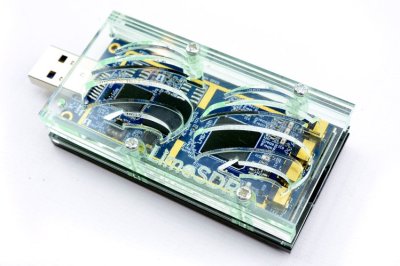
The board itself is a PCB about 33 mm x 70 mm (1,25 ” x 2.75 “), with a USB 3 plug at one end and a pair of SMA sockets at the other, one for receive and the other for transmit. The integrated circuits are all on the top of the board, and though they have included footprints screening cans, they are not populated. There is a single multicolor status LED between the SMA sockets. It’s worth mentioning that there will be a laser-cut plastic case for the board, which is probably worth getting as it feels somewhat vulnerable as it is. Along with as the board, they supplied a pair of little rubber duck antennas for the 870 MHz band.
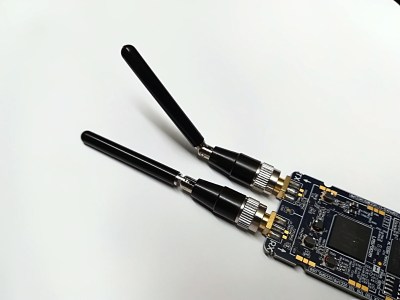
It is evident that the LimeSDR Mini is an extremely capable board that in the hands of a real expert in SDR and FPGA programming could have the potential for great things. It is also evident that as your Hackaday scribe I am not an SDR extreme power user. Despite holding an amateur radio licence for over three decades I have been a relative late comer to the world of SDRs, and have not progressed beyond RTL-SDRs or simple devices using a PC soundcard for baseband. But it’s probable that while many SDR programming experts will indeed buy this board, the majority of its customers will be similarly newcomers to the art. Therefore this review will be biased towards the SDR non-guru, the long-time radio enthusiast considering the LimeSDR Mini as a first transceiver.
The first task with any SDR will always be to install whatever software is required on the host machine. Here that means a copy of the latest Ubuntu distribution, but Windows and MacOS machines are also supported. There is a handy page of instructions, which in the case of Ubuntu require you to add a PPA repository for the drivers, then install the Lime Suite software and the SoapySDR abstraction layer. It is this final package that makes the LimeSDR an interesting prospect, by offloading software compatibility onto the widely used abstraction layer they hope to avoid some of the pain seen with other products.
Testing it Out

Once the drivers have been installed, it is time to decide which software to run first. The Lime Suite GUI supplied with the driver packages will be the first port of call to test the board, but I am told that the version in the PPA at the time of writing with the Mini not having been released is written with the LimeSDR USB in mind and therefore I should use GQRX. In the case of Ubuntu this can be installed through the graphical software installer, but as luck would have it I already had it on my machine. Selecting “other” as my SDR and pasting driver=lime,soapy=0 as my device string soon had the familiar interface in front of me, and with a suitable antenna in no time I was listening to my local BBC Radio 4 FM transmitter.
![A simple FM transmitter, derived from this example by [Gyaresu].](https://hackadaycom.files.wordpress.com/2018/02/fm-tx-gnu-radio.jpg?w=400&h=281)
Two things are immediately apparent to an owner of an RTL-SDR, gone are the huge number of spurious peaks, and the noise floor is much lower. Reading GQRX with different front ends is an inexact and even slightly meaningless way to take measurements, but with all-automatic AGC, the RTL has a -60 dB noise floor and the LimeSDR has one below -90 dB. Just looking at the FM band, there are stations poking out of the noise that simply don’t exist with the RTL. It’s unsurprising that a piece of dedicated SDR hardware would outperform a $10 TV stick running a hack to make it an SDR, but if you are an RTL-SDR user then you will be pleasantly surprised by the Mini when you see it in action.
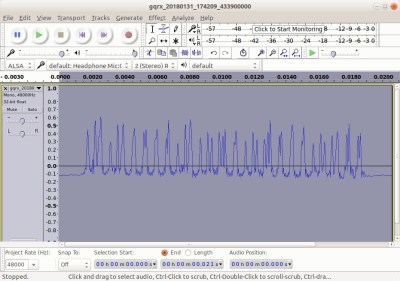
To have a board like the Mini and simply use it for GQRX is to waste so much of its potential. We are promised a library of tailor-made applications via Snappy Ubuntu Core, but this isn’t yet available pre-release. Your next stop would then probably follow ours with GNU Radio, and in particular its drag-and-drop GUI application GNU Radio Companion. This is nuts-and-bolts homebrew radio for the SDR age, just as analogue radio amateur homebrewers would solder their own radios while others bought shiny transceivers, so the SDR homebrewer can build their own devices using GNU Radio. It’s a package that’s beyond the scope of this review, but as an example when playing with the Mini it was fairly easy to cobble together a little GNU Radio receiver to pull in and extract the signals from a 433 MHz remote control transmitter we have in the house, and then regurgitate them through a 433MHz Baofeng antenna for the satisfying sight of a table lamp at the other end of the bench turning itself on. The Mini itself doesn’t intrude into this process beyond simply doing what it’s told once its communication with GNU Radio has been achieved, so experimenting further into the mechanics of decoding the bitstream itself became a matter of working through a set of tutorials and burning the midnight oil. The steep learning curve is amply offset by the satisfaction of playing with the instant gratification of radio building blocks without the pain of reworking any intricate soldering.
In transmission terms the maximum 100 mW output power is fairly modest for anyone used to amateur radio. But given that many applications for this board will involve the likes of sniffing for and responding to more local devices rather than seeking contacts from other continents this is something likely only to trouble radio amateurs without the wherewithal for a power amplifier. The twin antenna connectors will be somewhat annoying if you are used to a single one on a simplex transceiver, unless you are transmitting and receiving on different frequencies, of course.
A review of an SDR over a short period can not hope to cover all its many capabilities, so this one has been an impression of the Mini as a platform for experimentation and learning about how to use an SDR transceiver. But in just the time that it has been on the bench here, the Mini has opened a significant new vista over an RTL-SDR, and given a few months in which to play with GNU Radio will I am sure provide both some useful radio applications and a seriously interesting learning process.
Previous SDRs at the budget end of the market such as the HackRF have all remained somewhat expensive purchases, ones a typical radio amateur might have had difficulty concealing from their partner in the family accounts. With a price point that is almost edging into the realm of an impulse purchase, the Mini has the potential to become an SDR transceiver for everyone. If you have been holding back because of the price, maybe it’s time you gave it a look.
Voor de knutselaars: wat zijn die symbolen op adapters?

Look on the back of your laptop charger and you’ll find a mess of symbols and numbers. We’d bet you’ve looked at them before and gleaned little or no understanding from what they’re telling you.
These symbols are as complicated as the label on the tag of your shirt that have never taught you anything about doing laundry. They’re the marks of standardization and bureaucracy, and dozens of countries basking in the glow of money made from issuing certificates.
The switching power supply is the foundation of many household electronics — obviously not just laptops — and thus they’re a necessity worldwide. If you can make a power supply that’s certified in most countries, your market is enormous and you only have to make a single device, possibly with an interchangeable AC cord for different plug types. And of course, symbols that have meaning in just about any jurisdiction.
In short, these symbols tell you everything important about your power supply. Here’s what they mean.
It’s All About Market Access
How did every power supply end up plastered with hieroglyphics? It works like this; Acme Corp wants to sell a Thingamajig in Benchoffistan, so the company sends a pallet of Thingamajigs there. The Customs officer in Benchoffistan looks at this pile of goods and says “how will I know this thing is safe for my citizens to use? You must have appropriate certificates that say this product is allowed to be imported.” And just like that, an industry called “Market Access” is born.
Market Access deals with all kinds of problems: logistics, politics, taxes and tariffs, labels and user manuals, materials, timing, and even occasionally palm greasing. Every country has their own nuances, and there are some companies who specialize in helping negotiate this minefield. Russia requires special testing if a device uses encryption or connects to telecommunications equipment (BLE and WiFi both count). Many countries require in-country testing. Most require an in-country representative of the company to handle filings and communication. Some have lead times in the months.
Input/Output
 The first thing you’ll see on every power supply is the Input and Output. The input is almost always “100-240V~50-60Hz. The world runs power to outlets in this range. It means that as an input, the plug expects to be connected to that range of input voltage and frequency. The United States uses 120V/60Hz, Europe uses 230V/50Hz, so it’s nice that the input has a range within all of the countries.
The first thing you’ll see on every power supply is the Input and Output. The input is almost always “100-240V~50-60Hz. The world runs power to outlets in this range. It means that as an input, the plug expects to be connected to that range of input voltage and frequency. The United States uses 120V/60Hz, Europe uses 230V/50Hz, so it’s nice that the input has a range within all of the countries.
The output line has three pieces of information: the output voltage (typically 5V, 9V, 12V), a solid line over a dashed line indicating DC or a ~ indicating AC, and a current rating, usually in hundreds of milli-amps for smaller blocks that plug in, and amps for supplies where the brick is separate from the plug. When replacing a power supply, you’ll want to match the output voltage, match the AC/DC output, and the output amperage must be at least as big as the previous supply and it can be bigger. That number is just the maximum the supply is rated for, not how much it will deliver.
The next piece is the polarity. This looks like a circle with a + in it, a circle with a – in it, and a C in the center. Almost always, the – will point to the C and the + will point to a dot inside the C. This means that the plug has – (ground) on the outside and positive voltage on the inside. Some older plugs don’t conform to this, so you should always check before you uses a supply.
Generic Use
The house symbol means it’s meant for indoor use only, and the square inside a square means that the mains electricity is double insulated. The X through the garbage can means it should not be disposed of normally but instead recycled with other electronics.
Who Certified Your Power Supply?
There a few big companies that do the testing that have their own icons. It lends validity to the rest of the symbols if you can call up these companies and verify from a single source if they really do have each certificate.
You’ll most often see the UL symbol. UL is Underwriters Laboratories, which is a safety organization. They have a barrage of standard tests that they will run against the device to make sure that it is safe. In most cases, a UL certificate isn’t required for sale, but if your house burns down and it’s because of a non-UL listed supply blowing up, then the insurance company is going to put up a fight because you weren’t using safe equipment in your home. Many large retailers will require that your device be listed as well, since they don’t want to deal with any potential recalls or lawsuits from bad products. Next to each UL symbol should be a license number.
This is a good point to mention that many of these marks may be fake — I’ve run into that when sourcing USB power supplies for a product. Customs agents are going to see the symbol and may not follow up to see if the appropriate certificate actually applies to that product, so it’s not uncommon to look up a UL listing number and see pictures of a similar product. There’s some sort of balance, then, when investigating a product’s certificates. You want to see relevant certs and make sure they are legitimate, but you can’t check everything you touch.
What Countries Have Tested This Power Supply?
The rest of the symbols are going to be country specific, and there are a lot of countries with strange requirements for testing. Power supplies are one thing, but adding intentional radio emissions, like a WiFi or Bluetooth product, steps it up to a whole new level of testing and certifications that are beyond the scope of this article.
In general, the more certificates you see on a product, the less sketchy it is, and the bigger the company manufacturing the product. Small manufacturers aren’t going to have the money or interest to pursue a lot of certifications, and may be flying under the radar on a lot of their sales. It’s also an indicator that the product doesn’t change frequently, and that they’ve locked down their assembly line. You won’t see the manufacturer removing critical components to shave costs at the expense of safety.
Why is Donald Duck on the radio?

AM, or amplitude modulation, was the earliest way of sending voice over radio waves. That makes sense because it is easy to modulate a signal and easy to demodulate it, as well. A carbon microphone is sufficient to crudely modulate an AM signal and diode — even a piece of natural crystal — will suffice to demodulate it. Outside of broadcast radio, most AM users migrated to single side band or SSB. On an AM receiver that sounds like Donald Duck, but with a little work, it will sound almost as good as AM, and in many cases better. If you want a better understanding of how SSB carries audio, have a look at [Radio Physics and Electronics] video on the subject.
The video covers the math of what you probably already know: AM has a carrier and two identical side bands. SSB suppresses the carrier and one redundant side band. But the math behind it is elegant, although you probably ought to know some trigonometry. Don’t worry though. At the end of the video, there’s a practical demonstration that will help even if you are math challenged.
Dealing with signals as math equations are a staple if you seriously study electrical engineering. For example, you can model a pure sine wave with the equation: S(t) = A sin(2*pi*F*t) where A is amplitude, F is the frequency in Hertz, and t is time. Try it. In that example, the frequency is 1 kHz and the amplitude is 20, but you can tweak the values and see what happens. If you add something to the argument to the sin function, you’ll change the phase of the wave. If you followed that, you should have no problem with the video.
This math isn’t just good for working homework problems. It is the same math you need to do synthesis with a computer or digital signal processor. If you want to dig in, we talked about phase angle mathematics, earlier.
But wait, what’s with that screwy title? Have you ever heard an SSB signal on an AM radio? Most people describe it as sounding like Donald Duck. Listen at about the 20 second mark of this mp3 file and just after that, too where it is Upper Side Band (the other kind of USB) but off frequency and you’ll hear that famous voice. If all of this is unfamiliar, you need to explore the speech transmission origins of AM.
Measuring HF signal speeds in a DIY coaxial collinear antenna

Air Traffic Controllers use Automatic Dependent Surveillance-Broadcast (ADS-B) as an alternative to secondary radar to track aircraft. The ADS-B is transmitted by the aircraft and contains information such as GPS position, pressure, altitude, and callsign among other things at a 1090 MHz frequency, which can be decoded using any of a number of software tools.
[Mike Field] lives near an airport, and decided he wanted to peek into the tracking signals for fun. He turned to an RTL-based TV Dongle. Since the stock antenna was not cutting it, he decided to make one specifically for the 1090 MHz signal. His design is based on Coaxial Collinear Antenna for ADS-B Receiver by [Dusan Balara] which uses pieces of the coaxial cable cut to the right length. There are a number of calculations involved in determining the size of the cable, however, the hack in this design is the way he uses a USB based oscilloscope to measure the speed of RF waves inside the line in question.
We reached out to [Mike], and this is what he had to say. The idea is to use a cable of half the size of the wavelength which is calculated as
lambda = c/f
For the best reception, the sections of coax need to be half a wavelength long – but the wavelength of the signal inside the coax, which is shorter than the wavelength in free space. As this was a generic cable he had no idea of the dielectric that separates the core from the shield, so the ‘velocity factor’ could be anything depending on the exact composition.
To determine the speed of the signal in the cable, his approach omits the more expensive equipment. A length of coax acts as a stub – any energy that is sent into the cable reaches the far end of the transmission line and is then reflected back to the source. When the cable is 1/4th of the wavelength long, the reflected signal arrives back at the start of the signal 180 degrees out of phase – in a perfect world it would completely null out the input signal.

[Mike] starts his experiment with a 10m cable as he needs a test signal with a wavelength of 40m. In order to get the test signal into the cable, just two resistors at the back of a connector are all that was needed. The diagram shows the 330 ohms and 100 ohms in series with the center point at around 75 ohm which is a match for the cable.
Using the Digilent Analog Discovery 2’s Network Analyzer the connector is swept from 1kHz to 10Mhz without the cable attached, and then with the cable attached. The dip at 5.666 MHz, caused by the reflected signal down the coax is very clearly seen. From there it is simple math – 40m/cycle * 5,666,000 cycles per second = 226,640,000 meters per second or 75.6% of the speed of light.
So the wavelength of the ADS-B signal is (226,640,000 m/s) / (1090,000,000 Hz) = 0.208m, and the desired length to cut is 104mm 1/2 wave elements and 52mm 1/4 wave elements and get soldering!
This is a great example of how a little bit of math and human ingenuity can be better than expensive test equipment and if you looking to get into software defined radios from scratch, start with Scratch.
